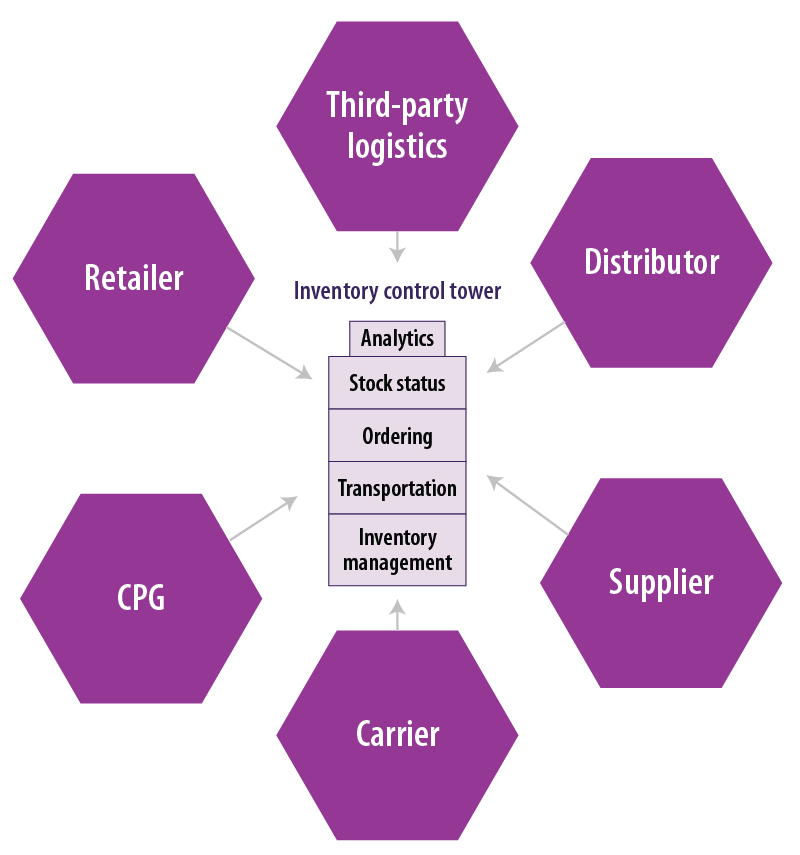Insights
- Getting supply chains to work efficiently and resiliently can be a contradictory mission. On one hand, things need to be lean and cheap to enable the most competitive services. On the other, supply chains need additional reserves of inventory, and an overcapacity in partners and supply routes, to deal with sudden challenges.
- Recent strides forward in AI, machine learning, blockchain, and other advanced technologies will help build the ability to deliver future-ready resilient supply chains
- Intelligent supply chains are built on three foundational elements — stock visibility across networks, automated decision making, and effective partnerships.
- These elements manifest themselves through concepts such as inventory control towers, artificial intelligence (AI)-enabled demand forecasting, and streamlined inventory information across the network.
- Beyond that, collaborations and strategic alignments among suppliers, manufacturers, and their customer-facing retailers remain crucial to achieve resiliency and efficiency.
COVID-19, global weather events, driver shortages, and the Suez Canal blockage exposed the fragility of global supply chains in 2021. The war in Ukraine and ongoing economic issues continue to challenge supply. This has renewed the focus to build intelligent supply chain systems that can cope with disruptions effectively.
Intelligent supply chains are built on three foundational elements — stock visibility across networks, automated decision making, and effective partnerships. These elements manifest themselves through concepts such as inventory control towers, artificial intelligence (AI)-enabled demand forecasting, and streamlined inventory information across the network.
In today’s environment, sustainability and the ability to cheaply facilitate product returns work as differentiators. However, the overall success largely relies on how efficiently retailers, consumer goods companies, and logistics organizations collaborate.
Stockless order fulfillment
Traditionally, retailers sell the stock they have. But, given the turbulent times, many retailers often don’t have that stock on hand. Stockless order fulfillment enables brands to create a network with retailers and distributors to share inventory data. If the stock is not available at the brand’s warehouse, orders can be fulfilled from the partner retailer’s warehouse. For example, under such an initiative, Adidas can directly ship products to customers of a fashion retailer Very, when the latter is unable to fulfill the orders directly.1
When consumers browse through brands or retailers, they can see the entire shared inventory. Orders are fulfilled from the nearest warehouse to the destination, allowing sellers to choose the most efficient way to deliver and delight customers.
Importantly, this helps to grow sales. A leading U.S.-based sporting goods company saw a sales lift of 20% annually, when it built a platform, in association with Infosys, to fulfill orders efficiently using a network of affiliates, marketplaces, and distribution centers across different markets.
AI-powered demand planning
Anticipating the demand in highly fluctuating environments is a major challenge for companies, especially for multiple products across geographies. Demand forecasting errors can lead to excess stock or out-of-stock situations. Regional factors such as weather, sports events, and cultural differences add to the complexities. Several parameters in a complex supply chain make it difficult to manage decisions and demand.
AI helps organizations identify relationships between datasets, recognize patterns, detect demand fluctuations, and recommend optimal stock levels for thousands of stock-keeping units at their distribution centers. AI-powered demand forecasting can reduce forecasting errors by up to 50% and inventory levels by 20-50%, reducing lock-in of working capital.
A European CPG company built predictive demand forecasting capabilities with the help of Infosys. The company could make weekly forecasts with 92% accuracy overall and 93% at an individual retailer level. It also built a dashboard to simulate forecasts by changing sales drivers such as price, promotion, distribution, and the number of products to accommodate the fluctuations.
Better demand forecasting capabilities can reduce the effort required to fire-fight sudden emergencies, allowing companies to focus on strategic initiatives.
Inventory control tower
Supply chain disruptions can be avoided with proactive planning, based on up-to-date inventory information. With many moving parts, a lack of visibility orchestrates a flexible supply chain. Inventory control towers provide real-time insights that enable organizations anticipate and fulfill demand. These towers become the single point of contact for information flow between multiple locations and parties. They integrate supply chain planning, ordering, transportation, and inventory management. These features make control towers a powerful tool to control end-to-end supply chain operations.
More sophisticated control towers can support faster and more automated decision-making, releasing teams to focus on other strategic tasks (Figure 1).
Figure 1. Control towers integrate information flow from different parts of supply chains

Source: Infosys
Returns management
Returns management (or reverse logistics) is possibly one of the most challenging processes in today’s retail environment. Today’s consumers return a significant proportion of goods, and expect an easy, cheap and quick way to do so. In 2021, almost 17% of products were returned in the U.S, according to a survey by the National Retail Federation.2 This can impact retail supply chain at various levels, such as warehousing, inventory management, and profitability. But a strong foundation of collaboration, technology, and processes makes reverse logistics manageable and cost effective.
Visibility of shipment movement and tracking information across all departments can help plan and organize resources around returns. A cloud-based portal that integrates data and systems can create a single source of information for stakeholders to work in collaboration. Such analytics can help concerned departments make quick decisions on reselling and identify patterns of returns. It can also recommend corrective actions to avoid possible returns, help devise marketing strategies to incentivize customers to buy returned goods and optimize markdowns on returned items to maximize the recovered value.
Consider a case where Infosys supported a leading European sporting goods company in reducing its returns rate using analytics. This company’s e-commerce returns rates in Western Europe were much higher at 25% than the standard of 16% for the retail fashion industry.3
The company developed the ability to understand the behavior of habitual returners using real-time analytics and built tailored engagements for such consumers. The result was a 5% reduction in losses from returns.
Sustainable supply chain
CPG companies’ supply chains account for more than 80% of greenhouse emissions, according to a survey by Carnegie Mellon University and McKinsey.4 While sustainability has gained CEOs’ attention in recent years, implementation and execution in the core supply chain design will take time.
While companies undertake sustainability initiatives internally, the impact on their extended supply chains is not significant. A report by Bain & Company says that about 60% of executives have zero visibility beyond the first level of their suppliers.5 If companies are to reduce emissions, they must have better visibility across supply chains so that they can work with their partners to become more sustainable.
Cargill, a leading U.S.-based food company, has developed a portal for consumers to see where and how its cocoa, palm, and other products grow.6 Also, Unilever has pledged to achieve net-zero emissions for its products, from sourcing to the point of sale.7 Unilever is working with its suppliers to reduce carbon footprint at each link of the supply chain.
Localism is also garnering attention, as it minimizes transportation costs, reduces emissions, and provides greater control over provenance than a widespread supply chain network.
Build resilient and sustainable supply chains, together
Getting supply chains to work efficiently and resiliently can be a contradictory mission. On one hand, things need to be lean and cheap to enable the most competitive services. On the other, supply chains need additional reserves of inventory, and an overcapacity in partners and supply routes, to deal with sudden challenges. Getting a right balance can be difficult, but organizations need to achieve that in harmony with partners.
A deep integration of data and execution, with flexibility and interchangeability of suppliers and strategies, is required. Recent strides forward in AI, machine learning, blockchain, and other advanced technologies will help build the ability to deliver future-ready resilient supply chains. Beyond that, collaborations and strategic alignments among suppliers, manufacturers, and their customer-facing retailers remain crucial to achieve resiliency and efficiency.
References
- Very launches stockless fulfilment model with Adidas and Reebok, Tom Shearsmith, October 27, 2021, The industry.fashion.
- A more than $761 billion dilemma: Retailers’ returns jump as online sales grow, Melissa Repko, January 25, 2022, CNBC.
- Online returns in Europe, E commerce news.
- Starting at the source: Sustainability in supply chains, November 11, 2016, McKinsey.
- 4 ways industry can make supply chains more sustainable, Francisco Betty, Hernan Saenz, and Juliane Stephan, September 18, 2020, World Economic Forum.
- CocoaWise portal keeps sustainability data at the fingertips of Cargill’s cocoa and chocolate customers, October 01, 2020, Cargill.
- Partnering with suppliers to deliver net zero, 2021, Unilever.

